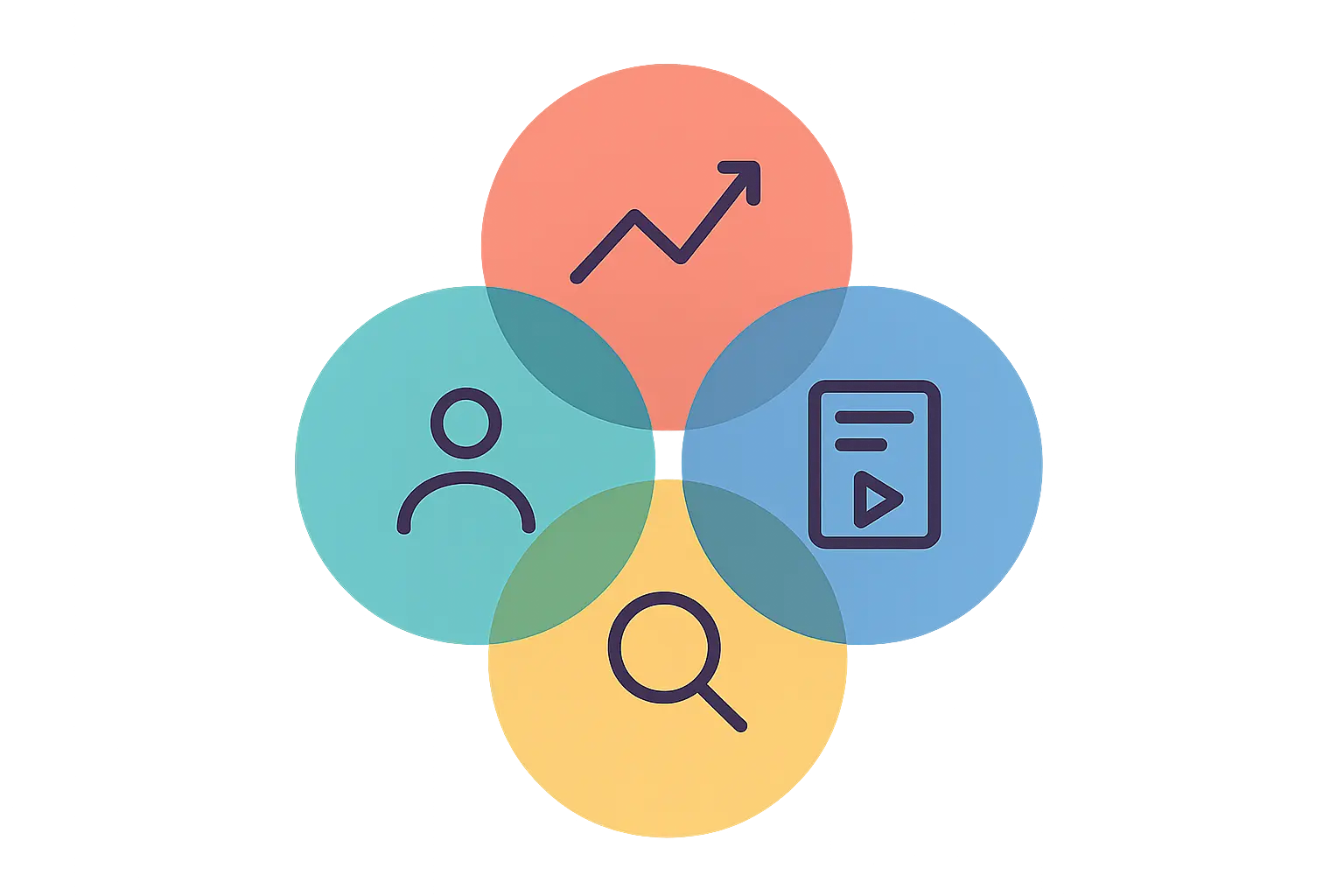Table of Contents
-
Understanding Instagram Case Study Fundamentals
-
Choosing the Right Campaigns to Analyze
-
Breaking Down Content Strategies That Actually Work
-
Decoding Audience Engagement Patterns
-
Measuring Performance Beyond Vanity Metrics
-
Gathering Competitive Intelligence
-
Turning Insights Into Actionable Strategies
-
Testing and Optimizing Your Approach
-
Final Thoughts
TL;DR
-
You need a simple system for picking campaigns to study – look for real performance numbers and innovation that actually makes sense
-
Visual storytelling consistency and smart hashtag usage are what separate successful campaigns from pretty failures
-
Quality engagement beats follower counts every single time when you’re trying to figure out what actually works
-
Tracking how people actually buy stuff helps connect Instagram activity to real business outcomes
-
Competitive stalking (the professional kind) reveals content gaps and opportunities you’re missing
-
Testing frameworks make sure the insights you steal actually work for your specific situation
-
Regular check-ins and strategy tweaks maximize your Instagram ROI over time
Understanding Instagram Case Study Fundamentals
Here’s the thing – most of us are doing Instagram analysis completely wrong. We scroll through successful posts, screenshot what looks cool, and wonder why our attempts fall flat every single time.
I used to be that person who’d spend hours stalking competitor accounts at 2 AM, saving their best posts to a folder labeled “inspiration” that I’d never actually use effectively. Sound familiar?
The real breakthrough came when I stopped trying to copy what looked pretty and started asking “why did this actually work?” After going down Instagram rabbit holes for months, analyzing everything from tiny local bakeries to massive beauty brands, I realized that what you see on the surface is just the tip of the iceberg.

Every post that actually drives results sits on top of a bigger strategy – audience research, competitor stalking, and constant testing. The pretty picture you’re looking at? That’s just one piece of a much larger puzzle.
When I analyze campaigns now, I focus on three things: what was the game plan, how did they actually execute it, and what numbers proved it worked. This approach reveals patterns you can actually steal (legally) for your own campaigns.
Understanding engagement is crucial for this kind of analysis, and honestly, our instagram engagement rate calculator has saved me countless hours of manual math when I’m trying to figure out if a campaign actually performed well or just looked good.
The most valuable stuff comes from understanding the “why” behind decisions, not just copying what someone else did. You need to know the business situation, who they were targeting, and what their competition was doing.
According to Sprout Social’s research, 84% of social users have Instagram profiles. That’s not just casual scrolling – these people cared enough to actually create accounts, which tells you they’re invested in the platform.
Choosing the Right Campaigns to Analyze
I wasted weeks analyzing campaigns that looked impressive but taught me absolutely nothing useful for my situation. That’s when I learned that picking the right campaigns to study makes or breaks your entire analysis.
The campaigns worth your time share specific traits that make them goldmines for actionable insights. They show clear results, do something innovative (without being completely weird), and tackle goals you can actually measure.
|
What to Look For |
Must-Have |
Nice-to-Have |
Skip It |
|---|---|---|---|
|
Real Results |
Clear ROI data, 3%+ conversions |
Good engagement, growth metrics |
Just vanity numbers |
|
Innovation |
Solving real problems creatively |
Creative but within reason |
Totally out-there stuff |
|
Relevance |
Matches what you’re trying to do |
Somewhat related goals |
Completely different business |
|
Data Available |
Full performance breakdown |
Some solid metrics |
Surface-level fluff only |
|
Can You Actually Do This? |
Adaptable ideas |
Some transferable parts |
One-off lucky breaks |
Performance-Based Selection Methods
I start every analysis by looking at numbers that actually matter for business growth. Engagement rates tell part of the story, but conversion metrics show you what really happened.
The campaigns worth studying show clear connections between Instagram activity and actual business results. This means you can follow the breadcrumb trail from someone seeing an Instagram post to them actually buying something.
ROI data is the holy grail, but let’s be real – most companies don’t share their exact numbers. When you can’t get the real ROI data, look for clues: steady engagement growth, more people talking about the brand, and signs they’re actually getting new customers.
Here’s a perfect example: JCDecaux took a 100-year-old woman named Marina and put her 54 Instagram posts all over Madrid’s subway system. The result? Her Instagram followers grew by 39,285%, she got 1.5 million profile views, and JCDecaux had their best booking period ever with double the media spend from 185+ new clients. That’s not just cute – that’s business results.

Innovation and Creativity Indicators
Creative innovation on Instagram isn’t about being the loudest person in the room. The campaigns I learn the most from show smart creativity that actually serves a purpose while pushing boundaries just enough to stand out.
I look for campaigns that solve common Instagram headaches in unexpected ways. Maybe they figured out a clever workaround for the link-in-bio problem, or they cracked the code on user-generated content that people actually want to create.
The best innovative campaigns stay true to their brand while trying new things. This balance between creativity and staying focused gives you insights you can actually use.
Breaking Down Content Strategies That Actually Work
Content strategy goes way deeper than pretty pictures and clever captions. The campaigns that consistently get results operate on multiple levels at once – they tell great visual stories, stay consistent with their brand, get discovered by the right people, and play nice with Instagram’s algorithm.
When you’re analyzing content strategies that work, you need to measure their effectiveness properly. That’s why I always use our marketing ROI calculator to connect Instagram content performance to actual business results.
The “Posting Patterns in Paris” case study shows how even specialized institutions can kill it on Instagram. The Bibliothèque Forney (a fashion library) focused their content on patterns and materials from their collection and achieved one of the highest engagement rates globally for fashion libraries. They aligned their content with both their brand and what their audience actually responded to.
Visual Storytelling Analysis
The accounts that really work don’t just post beautiful images – they create visual stories that guide how people think and feel about their brand over time.
When I’m breaking down visual storytelling, I look for the consistent elements that make you recognize a brand even without seeing their logo. This includes their color schemes, how they compose shots, what subjects they choose, and how they arrange elements in their posts.
Successful visual storytelling also shows they really understand their audience and how Instagram works. The best accounts adapt their visual approach based on what actually performs while keeping their core brand identity intact.

Hashtag and Discovery Strategy
Here’s where you can instantly tell the difference between someone who just posts for fun and someone who’s actually strategic about Instagram. Hashtag strategy matters more than almost anything else.
Smart hashtag strategies balance reach with quality. You want some high-volume hashtags for broad discovery, but you also need niche-specific ones that attract people who actually care about what you’re selling.
The most successful accounts I’ve studied track which hashtags actually work and adjust their strategy based on real data, not just what’s trending or what looks popular.
MAC Cosmetics nails this with branded hashtags like #MACGirls and #MACArtistChallenge. These hashtags do double duty – they grow MAC’s follower network organically while getting customers to create content that reaches even more people. It’s community-driven discovery that actually works.
Decoding Audience Engagement Patterns
Engagement patterns show you the difference between accounts that build real communities and those that just collect followers. The patterns I find most valuable show clear connections between how people engage and actual business results.
Real engagement analysis goes way beyond counting likes and comments. You need to look at the quality of interactions, whether engagement stays consistent over time, and what types of content actually get meaningful responses from people.
Research from Sprout Social shows that 50% of Instagram users interact with brands at least once a day. That means having a brand presence on Instagram creates real opportunities to connect with people and build relationships.

Community Building Strategies
The accounts with the strongest communities create spaces where people feel genuinely connected to the brand and each other. They don’t just broadcast content – they actually foster real interaction and participation.
Building community requires consistent interaction that goes way beyond just responding to comments. The most successful campaigns I’ve analyzed create content that encourages people to participate and then showcase that participation in meaningful ways.
User-generated content amplification is one of the most effective community building strategies I’ve seen. When brands thoughtfully showcase customer content, they create powerful social proof while making their audience feel valued and recognized.
Conversion Path Analysis
Understanding how Instagram followers become customers requires mapping the entire journey, not just tracking immediate link clicks or profile visits.
The most effective conversion paths I’ve analyzed create multiple touchpoints that gradually build trust and interest before asking for a purchase. This might include building an email list, retargeting campaigns, or multi-step engagement sequences.
Link-in-bio optimization is a critical bottleneck for most Instagram accounts. The successful campaigns I study show creative solutions that maximize Instagram’s limited linking options.
|
Stage |
What Happens on Instagram |
How to Optimize |
What to Measure |
|---|---|---|---|
|
Discovery |
Hashtag discovery, Explore page |
Smart hashtag mix, consistent visuals |
Reach, impressions, profile visits |
|
Interest |
Content engagement, Story views |
Educational content, behind-the-scenes |
Engagement rate, Story completion |
|
Consideration |
Link-in-bio clicks, DMs |
Optimized landing pages, quick responses |
Click-through rate, response time |
|
Purchase |
Shopping tags, external links |
Streamlined checkout, retargeting |
Conversion rate, attribution tracking |
|
Loyalty |
Community engagement, UGC |
Loyalty programs, exclusive content |
Repeat engagement, customer lifetime value |
Measuring Performance Beyond Vanity Metrics
Vanity metrics have killed more Instagram strategies than algorithm changes ever did. The campaigns worth studying focus on measurements that actually correlate with business success.
I’ve learned to ignore follower counts, total likes, and other metrics that look impressive but don’t predict business outcomes. Instead, I focus on engagement quality, tracking how people actually buy stuff, and long-term audience value.
You need proper ROI measurement for any Instagram analysis, and implementing comprehensive ROI calculator frameworks helps you tell the difference between campaigns that look successful and those that actually drive business results.

Key Performance Indicator Development
Effective KPIs connect Instagram activity to business outcomes through metrics that actually predict success. You need to understand which Instagram behaviors correlate with getting customers, keeping them, and increasing their lifetime value.
Engagement rate calculations need more sophistication than simple like-to-follower ratios. The most valuable measurements account for follower quality, how different content types perform, and industry-specific benchmarks that give you meaningful context.
Sentiment analysis helps you understand the emotional impact of your Instagram presence. This goes beyond counting positive and negative comments to assess overall brand perception reflected in audience interactions.
Attribution Modeling for Instagram
Instagram rarely drives direct conversions by itself. The most accurate performance measurement requires understanding how Instagram interactions influence customer behavior across multiple touchpoints and channels.
Multi-touch attribution reveals Instagram’s true business impact by tracking how Instagram engagement influences email subscriptions, website visits, and eventual purchases that might happen through other channels.
The attribution models I find most useful account for the extended customer journey that often starts with Instagram discovery but includes multiple touchpoints before someone actually buys.
According to Sprout Social data, 29% of users make purchases directly on Instagram, making it the third-most-used social platform for purchasing. This shows Instagram plays a significant role in the conversion funnel and why proper attribution modeling matters.
Gathering Competitive Intelligence
Competitive analysis on Instagram requires simple systems that go beyond casually stalking competitor posts. The most valuable intelligence comes from understanding competitor strategy patterns and performance trends over time.
I track competitor performance across multiple dimensions: how their content strategy evolves, audience engagement patterns, how quickly they adopt new features, and their apparent business results. This comprehensive view reveals strategic opportunities and potential threats.

Market Share Analysis Market share on Instagram isn’t just about follower counts – it’s about understanding your brand’s relative presence and influence within your industry’s Instagram ecosystem. Share of voice calculations track brand mention frequency, reach, and sentiment compared to competitive benchmarks. This gives you clear indicators of your Instagram presence relative to industry competitors. Content gap identification reveals underserved topics, formats, or audience segments that present growth opportunities. The most successful campaigns I study consistently identify and fill content gaps before their competitors do.
Benchmarking and Best Practice Extraction
Effective benchmarking goes beyond copying competitor tactics to understanding the principles that drive their success. You need to analyze the context and reasoning behind competitor decisions.
Cross-industry learning often provides the most innovative insights. Strategies that work in completely different industries can often be adapted to your specific market with powerful results.
The benchmarking frameworks I find most valuable focus on extracting adaptable principles rather than copying specific tactics that might not work in different business contexts.
“The Harris Poll’s Instagram brand tracking case study” shows how systematic monitoring helped track Instagram’s journey through a brand crisis in September 2021, when internal Facebook research leaked questioning Instagram’s safety for young users. This case shows how critical continuous brand monitoring and crisis response measurement are in competitive intelligence gathering.
Turning Insights Into Actionable Strategies
Case study insights only become valuable when you can successfully implement them within your specific business context and resource constraints. This requires simple systems for strategy translation and execution.
The implementation frameworks I’ve developed focus on adapting successful strategies rather than copying them directly. This involves understanding the core principles behind successful campaigns and applying those principles to your unique situation.
Strategic planning requires comprehensive budget allocation, and using tools like our marketing budget calculator ensures that Instagram campaign investments align with broader marketing objectives and expected returns.

Campaign Planning and Execution
Successful campaign implementation requires translating case study insights into specific action plans that account for your available resources, audience characteristics, and business objectives.
Content calendar development based on case study insights involves identifying the content patterns and posting strategies that drove success in your analyzed campaigns, then adapting those patterns to your content creation capabilities.
Budget allocation decisions should reflect the resource requirements demonstrated in successful case studies while accounting for your specific financial constraints and growth objectives.
Glossier shows effective campaign planning through their multi-layered Instagram strategy that combines product showcases with behind-the-scenes content from their headquarters. Their game plan includes regular Stories highlighting new products, authentic workplace content that builds trust, and consistent visual branding that maintains recognition across diverse content types. It shows how strategic planning translates insights into executable campaigns.
Testing and Iteration Frameworks
Testing frameworks ensure that case study insights actually work within your specific business context rather than assuming that successful strategies will automatically transfer to different situations.
A/B testing methodologies help validate which elements of successful campaigns are most important for your audience and business model. This requires simple testing protocols that isolate individual variables while controlling for external factors.
Performance monitoring systems track the ongoing effectiveness of implemented strategies and flag when adjustments are needed based on changing market conditions or audience behavior.
The most effective testing approaches I’ve developed focus on statistical significance requirements that ensure confident decision-making based on actual performance data rather than random variation.

Testing and Optimizing Your Approach
The gap between case study insights and real-world results gets bridged through systematic testing and optimization. Without proper testing frameworks, even the most promising insights can fail to deliver expected results.
I’ve learned that successful Instagram optimization requires treating every implementation as a hypothesis that needs validation. This approach prevents costly mistakes and identifies the specific adaptations needed for your unique business context.
A/B Testing Methodologies
Instagram A/B testing requires more sophistication than most people realize. Platform algorithms, audience behavior patterns, and external factors all influence results in ways that can mislead casual testing efforts.
The testing protocols I’ve developed account for Instagram’s unique characteristics: algorithm learning periods, audience fatigue factors, and seasonal variations that can mess up your results if you don’t control for them properly.
Sample size calculations for Instagram testing depend on your baseline engagement rates and the performance difference you’re trying to detect. Most tests I see end too early with inconclusive results because they don’t account for these statistical requirements.
Statistical Significance Requirements
Instagram testing requires sufficient sample sizes and testing durations to distinguish real performance differences from random variation. Most Instagram tests I see end too early with results that don’t actually mean anything.
The statistical requirements for Instagram testing depend on your baseline engagement rates and the size of performance difference you’re trying to detect. Higher engagement accounts need smaller sample sizes to achieve statistical confidence.
Testing duration matters as much as sample size. Instagram performance varies by day of week, time of day, and seasonal factors that require extended testing periods to account for natural variation.
I typically require at least 95% statistical confidence before making strategy changes based on test results, which often means longer testing periods than most people expect.
Variable Isolation Techniques
Effective Instagram testing requires isolating individual variables while controlling for factors that might influence results. This means testing one thing at a time rather than making multiple changes simultaneously.
The most common testing mistake I see is changing multiple variables at once, making it impossible to figure out which changes actually drove performance improvements or declines.
External factors like seasonal trends, algorithm updates, or what your competitors are doing can mess with your test results. Effective variable isolation accounts for these factors through control groups and extended testing periods.
The isolation techniques I find most reliable involve testing single variables across similar content types and time periods while keeping posting schedules and audience targeting consistent.
Alert System Configuration
Automated monitoring saves you from constantly checking Instagram analytics while ensuring you never miss critical performance shifts that need immediate attention.
I set up alerts for engagement rate drops, weird follower behavior, mention spikes, and conversion rate changes. These systems catch problems early and spot opportunities while you can still do something about them.
The most effective alert systems I’ve set up focus on percentage changes rather than absolute numbers. A 30% engagement drop matters whether you have 1,000 or 100,000 followers, but the absolute numbers look completely different.
Response protocols for different alert types help you react appropriately without freaking out over normal performance fluctuations. Not every metric change requires immediate strategy adjustments.
Quarterly Strategy Review Processes
Quarterly reviews prevent your strategy from getting stale by systematically incorporating new insights and market changes into your Instagram approach. These reviews balance consistency with necessary evolution.
I structure quarterly reviews around three key areas: how you performed against your established KPIs, what changed in the competitive landscape, and new case study insights that might inform strategy adjustments.
The review process includes evaluating which case study insights proved most valuable, identifying new campaigns worth analyzing, and adjusting testing priorities based on performance trends and business objectives.
Documentation during quarterly reviews creates valuable context for future strategy decisions and helps you spot long-term patterns that might not be visible in monthly performance reports.
Cross-Platform Content Adaptation
Instagram success doesn’t happen in a vacuum. The most effective strategies I’ve analyzed show clear integration with broader marketing efforts across multiple platforms and channels.
Adapting Instagram content for other platforms requires understanding which elements drive success and which are platform-specific. Visual storytelling principles often work well across platforms, but hashtag strategies and posting frequencies need platform-specific adjustments.
The content adaptation frameworks I find most effective focus on maintaining brand consistency while optimizing for each platform’s unique characteristics and audience expectations.
Cross-platform integration also means understanding how Instagram fits into your broader customer acquisition funnel and ensuring consistent messaging across all touchpoints.

Organic vs. Paid Strategy Balance
The most successful Instagram strategies I’ve studied show sophisticated understanding of when organic content needs paid amplification and when organic reach serves business objectives just fine.
Paid promotion works best when it amplifies already-successful organic content rather than trying to force engagement on content that doesn’t naturally resonate with your audience.
Budget allocation between organic and paid efforts should reflect your specific business model and growth stage. Early-stage businesses often benefit from organic focus, while established brands might get better ROI through strategic paid amplification.
The balance frameworks I’ve developed help determine optimal resource allocation based on audience size, engagement rates, and conversion performance across both organic and paid content.
Final Thoughts
Look, Instagram case study analysis transforms from academic exercise to business driver when you approach it systematically. The frameworks I’ve outlined help you extract actionable insights that actually improve your Instagram performance rather than just giving you interesting things to think about.
The most successful Instagram strategies I’ve encountered combine thorough case study analysis with systematic testing and continuous optimization. This approach ensures that your Instagram efforts actually contribute to business growth rather than just making your social media metrics look pretty.
Remember that case study insights require adaptation, not direct copying. Your audience, business model, and resources are different from the campaigns you’re analyzing, so successful implementation requires understanding core principles and applying them thoughtfully to your specific situation.
If you’re struggling to turn Instagram case study insights into strategies that actually drive business results, implementing comprehensive ROAS calculator frameworks can help bridge that gap by ensuring your Instagram investments deliver measurable returns that justify continued optimization efforts.
Ready to transform your Instagram case study insights into campaigns that actually drive business growth? Let’s talk about developing a comprehensive social media strategy that combines analytical rigor with creative execution for sustainable results.



